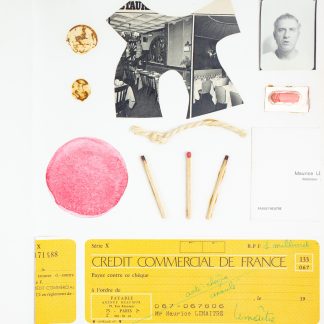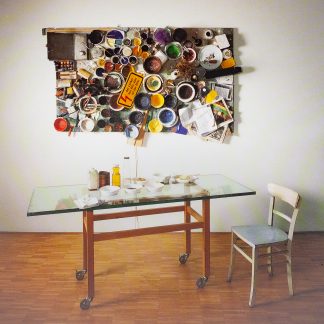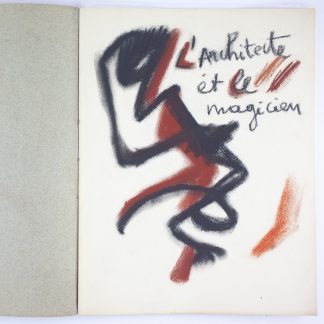Description
Set of three drawings by avant-garde dancer Lois Hutton, made while she was studying with Margaret Morris, a pioneering choreographer of free movement.
- Compostion "Ground design of dance/Fool's dance", 22 May 1919, gouache and charcoal on paper, 20 x 25.5 cm.
- Composition [Movement], 1920, gouache over pencil lines on paper, 23 x 30 cm. Dated on the back (May 16th 1920, Chelsea). Studio stamp.
- Composition "Background design", 1922, watercolour and pencil on paper, 26.5 x 36 cm. Signed on the back (Loïs Hutton, dec. 1921) and dated before Jan. 1922.
Although Lois Hutton became an artist in the 1930s whose work aroused the interest of Dalí, Man Ray and Picasso (the latter designed stage costumes for her), this formative period of her career has been little documented. Richard Emerson devoted a study to Hutton, Margaret Morris and Hélène Vanel, published in 2018 under the title Rhythm & Colour However, he reproduces only one original drawing by Lois Hutton from this period and appears not to have had access to anything more: a photo album cover made in 1922 (p. 128). The silhouettes, frozen in a pose and painted against a geometric background, echo the "Movement" composition presented here.
Loïs Hutton joined the Margaret Morris School as part of a summer course organised in 1918: a teacher at the Physical Training College in Chelsea, Hutton was no stranger to the dance world at the time. Margaret Morris, however, was breaking new ground by advocating the development of 'natural' movement free from the constraints of Italian ballet. This innovative approach - as well as the artist's sulphurous reputation - aroused the curiosity of the intelligentsia (Ezra Pound, Charles Rennie Mackintosh...) who gathered in the halls where Morris and her students presented their shows.
Attracted by his pedagogical approach, which encouraged the dancer's individual expression by making them responsible not only for the choreography but also for all the elements of the staging, Loïs Hutton joined the Morris School as a student teacher and studied visual arts with the Scottish painter John Duncan Fergusson. Morris claimed that the inclusion of visual arts in the training of dancers was what made his teaching so good. In an interview published in Arts and LettersIn her book, she details her theories on the gemelity of painting and movement: "I look at dancing from the visual point of view of the artist, seeing movements as visual combinations of shapes and lines, and ballets as pictures with the possibilities of actual movements added. I realised also that my feeling for construction in form and expression was entirely due to the study I had made of these things in painting, and that I was applying the same knowledge to produce ballet as to paint a picture" (Rhythm & Colour, p. 43)
Students at the Morris School could just as easily paint a draped set to match a dance of their own composition as use a background to develop a choreography. In the same interview, Morris elaborated: "The power of backgrounds and costumes to intensify, or merge, or harmonize and repeat the movement of figures is almost unknown and untried, and the scope is unlimited." (p. 43) The drawings presented here are part of this practice:
An abstract composition in watercolour and pencil bearing the annotation "background design" refers to the study of a stage background. Created in 1922, it already bears the hallmarks of the geometric decors that Loïs Hutton would create in collaboration with Hélène Vanel; the two artists broke away from the Morris School in 1924 to found the Studio Rythme et Couleur in Saint-Paul de Vence. Together, they developed a theory of the body as a medium in the service of an overall composition, which they disseminated in the Rhythm and colour notebooks.
A gouache and charcoal composition bearing the annotation "Ground design of dance/Fool's Dance" suggests that the dancers' involvement in the construction of the sets did not stop with the creation of the backgrounds. Lois Hutton composed the Fool's Dance at a period of great creativity marked by his study of traditional dances, and presented it for the first time to music by Edvard Grieg on 7 January 2020. This study, dated 22 May 1919, bears witness to her preparatory work. Margaret Morris gave it a score of 'Very good + costume' with no mention of scenery (p. 62) and the Fool's Dance became part of Hutton's permanent repertoire: a leaflet published in 1926 (p. 229) announced it, under the title 'Fool's Dance (danse humoristique)', in the programme of a performance given by the Rhythm and Colour Studio.
A final composition in gouache and pencil, dated 1920, captures the poses of five dancers against an abstract background. Whether a study based on live models or a preparatory drawing, it can be related to the original choreography presented by students at the Morris School at the time: the groups of dancers, posed in symmetrical arrangements, bear witness to the influence of the work of Isadora Duncan, who revolutionised the practice of dance by drawing inspiration from the positions adopted by ancient Greek athletes. Photographed during the Summer Schools organised by the Morris School in Devon, Wales and Dinard, these ensembles did much to spread the image of the Margaret Morris Movement.
This superb and extremely rare collection crystallises both the development of a key artist of the inter-war period and the history of the 'danse libre' movement within which she emerged.
Emerson, Richard. Rhythm and Colour. Edinburgh: Golden Hare. 2018.
Provenance: Loïs Hutton workshop.
Compostion "Ground design of dance/Fool's dance", 22 May 1919, gouache and charcoal on paper, 20 x 25.5 cm.
Composition [Movement], 1920, gouache over pencil lines on paper, 23 x 30 cm. Dated on the back (May 16th 1920, Chelsea). Studio stamp.
Composition "Background design", 1922, watercolour and pencil on paper, 26.5 x 36 cm. Signed on the back (Loïs Hutton, dec. 1921) and dated before Jan. 1922.





